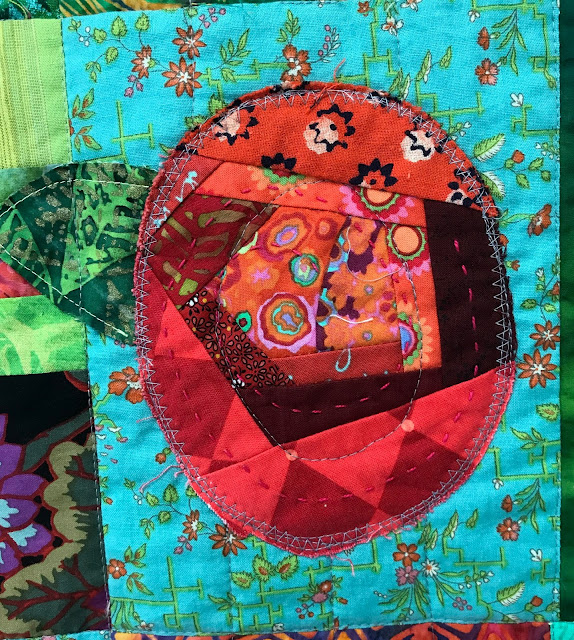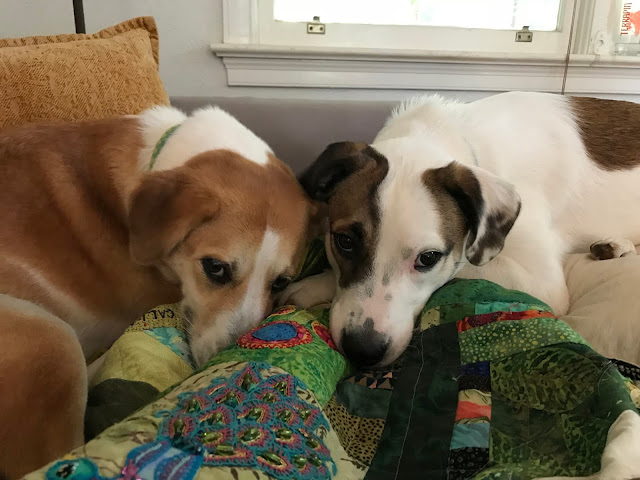During the Fall of 2019, before everything changed, Gees Bend artist
Mary Lee Bendolph filled five gaIleries at The Georgia Museum of Art (GMOA) in
Athens with her dazzling quilts. Her creations rival any artistic
medium, composed with balance and texture. Through her quilts you see a
mastery of color, the stitches setting the tempo as well as the
structure.
Ms. Bendolph is a foremother of the movement giving quilts and cloth expression
an appreciation as Art. Each of her quilts tells a story as old as our
lives. Her hands create a channel to the voices of her ancesters. The
grouping of her work as a whole felt immediately essential. It’s
apparent her quilts come from the depths of her soul.
Though generations of women who make quilts, my daughter Callan's work as Curator of Education at GMOA and the High Museum introducing her to Atlanta, I was honored to meet Ms. Bendolph and, on a later date, conduct a Hoop Quilting Workshop at the museum on campus at UGA. My goal was to provide an introduction to quilting without being hindered too much by technique. In two hours…
It was wonderful to share a rainbow of colors for people to choose from. With Ms. Bendolph's work providing our inspiration. My lifelong fabric collection has never been so happy.
 |
| Linda Jones |
 |
| Aunt Betty Baker |
 |
| Ms. Mary Lee Bendolph with her family of quilters. |
 |
| Under the watch of Ms. Bendolph's quilt, I made a 3-D progression |
 |
| Mary Lee Bendolph |
This Atlanta Sewing Circle reimagines the Hoop
workshop as an ‘At Home Project.”
Don’t follow rules and you’ll have more fun.
Supplies needed:
- Sturdy wooden Embroidery or Quilting HOOP, any size.
- Quilt fabric SANDWICH for this hoop circle is three squares about 5" wider than the hoop opening:
- 1-TOP Cotton fabric.
- 2-BATTING (or thin flannel)
- 3-BACKING fabric
- Fabric scraps to chop into shapes
- Basic Sewing Supplies: scissors, needles, pins and thread
During our workshop, we spent the first twenty minutes in the
galleries, soaking in Ms. Bendolph’s designs and imagining our own
circle of inspiration. Look through the hoop as a window. What colors and shapes bring you the most joy?
Check out the Gees Bend quilts and
their blocks of color. Check out Paul Klee or Sonya Delauney for great colors and design.
You could pencil outline the hoop circle on paper to sketch ideas. Simple
is powerful. Dark colors on light background or Light colors on Dark.
It doesn’t take large fabric pieces to make a great design.
You could use heirloom linens, cut to size. A circle hoop grouping can be powerful.
This Hoop will serve as a fab stretching tool while stitching and eventually your finishing frame. The Hoop screw is the top
of your circle. You can use it as a wall hook down the road.
Hints:
*Work only with the Quilt TOP fabric until it’s close to complete so put the Batting and Backing layers aside. You'll make the sandwich when ready.
Note: The batting isn't always necessary in a hoop. For thicker fabrics, sandwich Top cloth with Backing only, wrong sides together to make a slim sandwich. Decide if the texture is worth the extra bulk. After deciding the hoop placement, it's good to press fabric where it will be to reduce bulk there. Remember, No rules.
*The Quilt TOP can be used in many ways:
#1-Whole cloth (as is) with cut shapes and stitches added as
appliqué. Use a glue stick lightly in new shape center or pin to attach
before stitching in place. Work with the TOP in the hoop and adjust as
you go to keep it cinched flat. PS I hate glue and spray adhesives, they add unnatural elements but are used by many with great ease. No Judgement here.
#2-Pieced Top: Slice across the TOP and add a strip of contrasting
fabric to the opening. Try strips in colors as you like to add, finishing to the size of BACKING.
#3 Mandala: The nature of this circle having no beginning or end allows a mandala practice as you stitch your way around the hoop. I love having poppies emerge as picture shows below.
#4- Log Cabin: start with a small color square and add ~1-2” random
strips, sewn right sides together, ironed open each time. You’ll add
rows (logs) to the outside edge as you go, each row adding to the
cabin. Cut to match size of BACKING before you make the sandwich.
#5 Use the Whole Cloth approach, as in #1, and put a shape in the
center. Make colors with fabric scraps or threads in concentric circles
around the center shape. Leave part of the original fabric showing as
you circle around. Work your way back to the center with meditative
stitching. Create a mandala poppy or turtle with radiating circles.
Each layer is growth. Each radiating pattern is releasing your spirit.
When you get the TOP appliquéd/pieced as you like, layer with the
BATTING and BACKING. Trim layers to roughly the same size. Loosen the
screw to place the three-layered Quilt Sandwich inside the Hoop.
Now Quilt Becomes a Verb and is where your design comes to life.
 |
| Hoop Ideas. |
Hoop Quilting:
Thread the needle and put a fat knot* in one end of ~18” of Perle
(size 12, 8 or 5) cotton thread. Smaller size# is thicker. I like to
adjust needle size to a bit larger. I hate fighting a needle eye. With my older eyes.
Poke needle through from the back where you’d like to start.
Pull the thread tight then ¼” or so poke thru to the back. You’ve
just made a STITCH. Make more. Make a couple in a row and get into a
rhythm.
*Alabama Chanin makes their knot show on the top layer. No Rules.
To finish, tighten the screw at the Top and turn to the backside of
your Hoop. Iron around the backside rim so leftovers lay flat. Use big
Perle cotton thread to make a fat stitch around the backside of the
circle, 1-2” inside the Hoop edge. Use smaller lengths to gather-stitch
and knot segments around your circle. I often trim away the excess
fabric inside this finishing circle. Put your name on it. Add special
pins, mementos or earrings as part of the quilting. Extra points if you wire a small stick across the finished Top screw mechanism.
 |
| Chopstick chopped then wired to Top hoop screw |
 |
| Poppy as Turtle on random pieced top |
 |
The Underside or Backing.
Gather the finished fabric sandwich to back with big stitches 2" inside the hoop to finish.
Add a label or write directly on the backing fabric. I love stitches to show. |

































